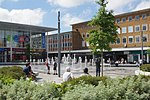Southgate, West Sussex

Southgate is one of the 14 residential neighbourhoods in Crawley, a town and borough in West Sussex, England. Crawley was planned and laid out as a New Town after the Second World War, based on the principle of self-contained neighbourhoods surrounding a town centre of civic and commercial buildings. Southgate was one of the four in the "inner ring" closest to the town centre, and was intended to be the largest of the nine designed in the original master plan. It was built in two stages between the 1950s and the 1970s, but retains some older buildings from before the New Town era and has "significant areas of pre-New Town character".The area was settled by pre-Roman people, and industrial and other artefacts from that era were found during construction of the neighbourhood. In the 19th century, after Crawley was connected to the national railway network, housing developed south of the line around the Brighton Road, which divides the modern neighbourhood in two. New Town-era expansion produced a large residential area with a high proportion of terraced houses and a range of schools, places of worship and community facilities; but some historic buildings and areas of open space remain, including an award-winning park. The population at the time of the United Kingdom Census 2011 was 8,533.
Excerpt from the Wikipedia article Southgate, West Sussex (License: CC BY-SA 3.0, Authors, Images).Southgate, West Sussex
Brighton Road,
Geographical coordinates (GPS) Address Nearby Places Show on map
Geographical coordinates (GPS)
| Latitude | Longitude |
|---|---|
| N 51.1078 ° | E -0.1918 ° |
Address
Brighton Road
Brighton Road
RH10 6AA
England, United Kingdom
Open on Google Maps










